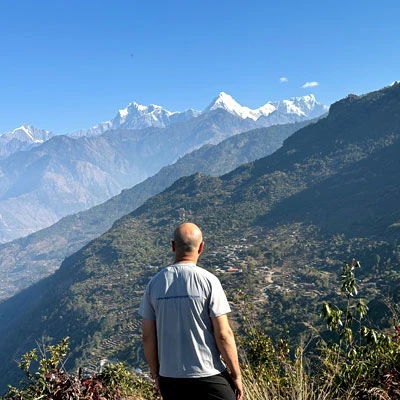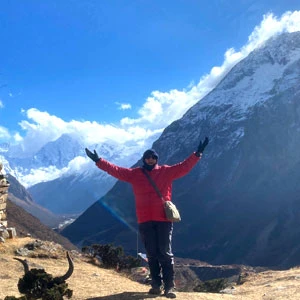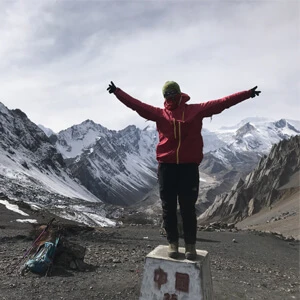What Makes the Tsum Valley Trek in Nepal So Special?
The Tsum Valley Trek stands out as one of Nepal’s most spiritually enriching and culturally immersive trekking experiences. Known as the “Valley of Happiness,” Tsum is a sacred destination for Tibetan Buddhists and the ancestral homeland of the indigenous Tsumba people.
What truly sets the Tsum Valley region apart is its remote location and unspoiled nature. Hidden deep within the Manaslu Conservation Area, this mystical valley is isolated from the outside world until it was officially opened to foreign trekkers in 2008. As a result, its ancient monasteries, chortens, and timeless Himalayan culture remain largely untouched by modernization.
Now, if you are seeking off-the-beaten-path adventures in Nepal, you can combine the Tsum Valley Trek with the Manaslu Circuit Trek to explore two of Nepal’s most scenic and culturally rich trekking regions in a single journey.
Permits Required For The Tsum Valley Trek In 2025
To trek in the sacred Tsum Valley in 2025, you will need three key permits: the Manaslu Restricted Area Permit, the Manaslu Conservation Area Permit (MCAP), and the Annapurna Conservation Area Permit (ACAP).
Manaslu Restricted Area Permit (Special Permit)
The Manaslu Restricted Area Permit (RAP) is a mandatory requirement for anyone trekking to the remote and culturally rich Tsum Valley in Nepal. This special permit controls access to the government-designated restricted zone within the Manaslu region, helping to preserve the fragile environment and unique Tibetan Buddhist heritage of the area.
It is only issued through the Department of Immigration in Kathmandu or Pokhara. Since solo trekking is prohibited, to obtain this permit, you must travel in a group of at least two people accompanied by a government-licensed guide affiliated with an authorized Nepal trekking company.
Here, the cost of the Manaslu special permit in 2025 depends on the trekking season. During the peak trekking months from September to November, the fee is USD 100 for the first seven days and USD 15 for each additional day. From December to August, it’s slightly cheaper at USD 75 for the first seven days and USD 10 per additional day.
It's important to note that the permit's validity begins at Jagat, the official entry checkpoint into the restricted area of the Manaslu and Tsum Valley trek route.
Manaslu Conservation Area Permit (MCAP)
The MCAP supports the protection of the area's rich biodiversity, endangered wildlife, and fragile alpine ecosystems. With it, the Nepalese government ensures that every visitor contributes directly to environmental conservation, trail upkeep, and the sustainable development of local communities across the Manaslu and Tsum Valley trekking route.
You can easily obtain the MCAP from the Nepal Tourism Board offices in Kathmandu or Pokhara. The cost of the MCAP for Tsum Valley in 2025 is NRs 3,000 per person, which is approximately USD 23. Unlike the restricted area permits, the MCAP has no time restriction, allowing flexible travel through the Manaslu Conservation Area without daily surcharges.
Annapurna Conservation Area Permit (ACAP)
The Annapurna Conservation Area Permit (ACAP) is also a mandatory requirement for trekkers on the Tsum Valley Trek if their route connects to or exits through the Annapurna region. Most itineraries end at Dharapani, where the Tsum Valley and Manaslu Circuit trails merge into the Annapurna trekking network.
The Nepal Tourism Board offices in Kathmandu and Pokhara issue this permit, and it remains valid for the entire duration of your trek. The ACAP cost for 2025 is NRs 3,000 per person, approximately USD 23, and there are no additional charges based on trek length or duration.
What Documents Do You Need For The Tsum Valley Trekking Permits?
When applying for the Tsum Valley Trek permits in 2025, you will need the correct documents ready in advance. Since the Manaslu Restricted Area Permit (RAP), MCAP, and ACAP are only issued through a government-registered trekking agency, you must submit a complete set of paperwork during your application.
For this, you will need a passport with at least six months of validity remaining. Additionally, you will need four recent passport-sized photos. Here, you should also carry a few photocopies of your passport, as these are typically requested when applying for the restricted area permit and the conservation area permits through the Nepal Immigration Offices in Kathmandu or Pokhara.
On a similar note, you will need a copy of your travel insurance policy, which must clearly cover high-altitude trekking in Nepal, medical evacuation, and emergency services, especially since the Tsum Valley Trek reaches remote and elevated terrain. You will also need to provide your detailed trekking itinerary and submit information about your licensed guide and the authorized trekking agency handling your permit.
Updated Tsum Valley Trekking Permit Regulations (2025 Rules & Restrictions)
- Your trekking group must have a minimum of two trekkers.
- Solo trekking is strictly prohibited in the Tsum Valley (as it's part of the restricted Manaslu region).
- Your trekking group must be accompanied by a liscensed trekking guide. Also, note that, freelance guides are not acceptable.
- You must apply for the permits through an officially registered trekking company in Nepal.
- You will need to apply the permits beforehand as no permits are issued at the entry point or checkpost.
- You must present your permits at several checkpoints, including Jagat, Lokpa, Philim, Chumling, Chhekampar, and Mu Gompa.
- If you fail to show your permits in required checkpoints, you may be fined or at worst, denied for further trek.
- Once issued, permits are non-refundable and non-transferable, even if your plans change or the trek is cut short.
- The Manaslu Special Permit is date-specific, and the duration is calculated from Jagat onward.
- There is no time limit on ACAP or MCAP once issued, but your trek must remain within the stated entry and exit points.
- For the permits, you will need to show valid documents such as passport, Nepal visa page, passport-size pictures, and travel insurance details.
Tsum Valley Trek Permit Cost Breakdown (Updated Rates for 2025)
Permit Type | Time Period | Cost | Where To Get |
Manaslu RAP | Sept to Nov | USD 100 for 7 days & USD 15 for each additional day | Immigration Office (Kathmandu/Pokhara) |
Manaslu RAP | Dec to Aug | USD 75 for 7 days & USD 10 for each additional day | Immigration Office (Kathmandu/Pokhara) |
MCAP | All year | NPR 3,000 (approx. USD 23) | NTB (Kathmandu/Pokhara) |
ACAP | All year | NPR 3,000 (approx. USD 23) | NTB (Kathmandu/Pokhara) |
Important Tips On Getting The Tsum Valley Trekking Permits
- Since permit processing takes time, you must apply for the permit few days before the trek.
- The government offices in Nepal including Immigration and Tourism Board are closed during the weekends and public holidays, so you should target to issue permit during workdays.
- You should hire a registered trekking agency to handle all paperwork, guide coordination, and ensure compliance with current regulations.
- Keep both the hard copy and scanned versions of the permits on your phone/cloud and carry printed copies for checkpoint inspections.
- As the permit durations (especially for the Manaslu Special Permit) are tied to your route and timeline, starting from Jagat, you should confirm your itinerary with the agency.
- Permit regulations can occasionally change, therefore, you must verify the latest updates with your agency or Nepal Tourism Board.
Penalties & Fines for Trekking Tsum Valley Without a Permit (Updated 2025)
Failing to follow the Tsum Valley Trek permit regulations can result in serious consequences for both trekkers and trekking agencies. With increasing concerns over environmental degradation, unregulated tourism, and safety in Nepal’s restricted trekking regions, authorities have significantly strengthened permit enforcement across the Manaslu and Tsum Valley region since 2024.
If you attempt to trek without the mandatory Manaslu Restricted Area Permit (RAP), MCAP, ACAP, or without a licensed trekking guide, you may face hefty fines, immediate removal from the trail, or even legal action that could impact your ability to travel in Nepal in the future. The government strictly prohibits solo trekking in restricted zones like Tsum Valley, and all foreign trekkers must be part of an officially registered group.
Along the route of the Tsum Valley, there are several checkpoint officers stationed at various points like Jagat, Lokpa, and Chumling. These checkpoints are staffed by officers who have the authority to inspect documents, deny passage, confiscate incomplete permits, or escort unauthorized individuals back to the nearest settlement.
Conclusion
Respecting the permit rules for the Tsum Valley Trek is about more than just following regulations, it’s about trekking responsibly. These permits fund vital conservation efforts, protect delicate mountain ecosystems, and empower local communities through sustainable tourism. It also ensures your safety and legal travel within a remote corner of Nepal.
If you are planning this unforgettable journey, let Nepal Trekking Experts take care of the logistics. Their experienced team makes the permit process stress-free and ensures you trek with a licensed guide, follow updated routes, and make the most of your time in the Himalayas.
FAQs
Do I need a special permit to trek in Tsum Valley?
Yes, the Tsum Valley lies in a restricted area of the Manaslu region, so you will need a Manaslu Special (Restricted Area) Permit in addition to MCAP and ACAP.
Can I trek to Tsum Valley solo or without a guide?
No, solo trekking is not allowed. You must trek in a group of at least two people with a licensed guide from a registered agency.
How much does the Tsum Valley Trekking permit cost in 2025?
The Manaslu Special Permit costs USD 100 for the first 7 days (Sep to Nov) or USD 75 (Dec to Aug), with extra daily fees thereafter. MCAP and ACAP cost NPR 3,000 (approx. USD 23) each.
Where can I get the permits for Tsum Valley Trek?
You can get the permits in advance through a registered trekking agency. The agency will process them at the Immigration Department and Tourism Board in Kathmandu or Pokhara.
Is the ACAP permit mandatory to trek the Tsum Valley?
Only if your trek exits through the Annapurna region (e.g., via Dharapani). Otherwise, ACAP isn’t necessary.
What documents are needed to apply for Tsum Valley Trekking permits?
You will need a valid passport, Nepal visa, passport-sized photos, and your trekking itinerary arranged by a registered agency.
Are permits checked along the Tsum Valley trail?
Yes, permits are checked at multiple checkpoints, including Jagat, Lokpa, and Chumling.
Can a freelance guide help me get the Tsum Valley permit?
No, only guides from registered agencies can lead restricted area treks. Freelancers are not accepted for permit approval.
How early should I apply for the Tsum Valley permits?
It’s best to apply 1 to 2 days before your trek begins to allow enough time for processing.
What happens if I trek Tsum Valley without a permit?
Trekking without proper permits can lead to fines, expulsion from the trail, and legal consequences for both you and your guide.







